This article is based on a poster originally authored by An Ouyang, Spencer Chiang and Chao Wang.
Antibody-drug conjugates (ADCs) are a new class of anti-cancer therapeutics that are both novel and highly targeted. Grafting monoclonal antibodies to a cytotoxic payload enables a highly potent vectorized chemotherapy that has shown significant potential in treating various cancers.
A number of developmental factors can impact ADCs’ efficacy, however, including monoclonal antibody quality, the selected target protein, linker stability, payload, and most notably, the conjugation method.
Most conjugation methods employ random conjugation, which regularly leads to poor stability and variable efficacy. A site-specific conjugation method represents a more ideal approach because it precisely controls the conjugation site to produce a homogenous mixture. This is a particularly promising path towards improved ADC design.
This article explores the use of ACROBiosystems’ AGLink site-specific conjugation kit to perform site-specific enzymatic modification of IgG Fc glycans. The kit is also used to evaluate the homogeneity and cytotoxicity of the resulting ADC conjugation.
Understanding ADCs
Antibody-drug conjugates (ADC) are generally comprised of a monoclonal antibody (mAb) attached to a cytotoxic payload. A chemical linker facilitates this attachment.
ADC development necessitates the careful consideration of each key component and development approach because each individual element can potentially impact the safety and efficacy of the final therapeutic.1
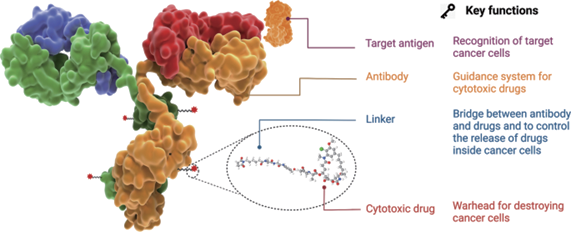
Figure 1. The structure, components and functions and characteristic of an ADC drug.1 Image Credit: ACROBiosystems
The drug-to-antibody ratio (DAR) is an important characteristic of any ADC drug. This ratio provides the number of drug molecules bound onto a single antibody – a value that typically varies based on the conjugation strategy employed.
Low drug loading lowers overall potency, while high drug loading can lead to increased side effects and altered pharmacokinetics (PK), as well as higher cytotoxic effects. An appropriate conjugation strategy must be employed because this can significantly impact ADCs’ homogeneity and their resulting effectiveness.2,3
Traditional conjugation techniques conduct non-specific conjugation on pre-existing cysteine or lysine residues using appropriate coupling reactions. This approach can lead to highly variable DAR, ranging from 0 to 8, as well as a range of linker positions. This results in the production of heterogeneous ADCs.1,2,3
Site-specific conjugation technologies such as unnatural amino acids, engineered cysteine residues, or enzymatic conjugation via glycosyltransferases, have been applied to obtain more homogeneous ADCs and improve their efficacy.3
This approach has proven to be clinically effective, enhancing both ADC pharmacokinetics and its therapeutic index. Increased control over the conjugation site reduces overall linker‒payload hydrophobicity, preventing unintended payload release in blood.3
In the example presented here, site-specific conjugation was performed using AGLink ADC site-specific conjugation kits. The AGLink technology employs a novel enzymatic modification method (one-pot process) to reduce antibody N-glycans by fucosylation while facilitating controllable site-specific conjugation.4
Resulting ADCs were evaluated for ADC homogeneity, immunoreactivity, and cytotoxicity following conjugation.
Methods and materials
AGLink ADC site-specific conjugation kits (ACROBiosystems, Glyco-therapy Biotechnology; Cat. No. ADC-P005; Cat. No. ADC-P009;) were used. These were based on the conjugation platform YTConju™ (Glyco-therapy Biotechnology Co., Ltd.).4
Conjugation method

Figure 2. Conjugation mechanisms using the AGLink ADC Conjugation Kit. Two different conjugation methods are proposed above with either a DAR of 2 or 4. Suitable glycoforms that are compatible for enzymatic modification are listed below. Image Credit: ACROBiosystems
Results
Trastuzumab and MMAE were used to characterize the AGLink efficacy, with N-glycans identified at the asparagine 297 (N297) position of the CH2 domain on each individual heavy chain Fc fragment.
The N-glycans were reduced to form reactive sites linked with payloads via glycosylation.1
The resulting glycosylation was noted to be predominantly comprised of varied amounts of N-acetylglucosamine, galactose, mannose, and N-acetylneuraminic acid (sialic acid) residues. These were assembled in various complex-type biantennary structures.4
Varying studies were used to develop and characterize the resulting ADCs (Trastuzumab-MMAE) with different DARs (2 or 4).
High homogeneity conjugated antibodies
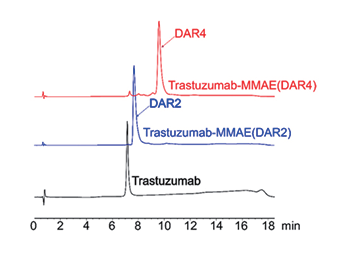
Figure 3. HIC-HPLC analysis of MMAE ADCs (DAR 4 & DAR 2). A shift in retention time was observed for higher DAR ADCs result associated with to the hydrophobic payload (MMAE). After conjugation using AGLink ADC kit, it can be observed that the resulting ADCs are highly homogenous for both DAR2 and DAR4 conjugation mechanisms. Image Credit: ACROBiosystems
Preserved bioactivity after conjugation
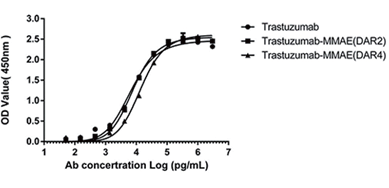
Figure 4. ELISA analysis was performed to test the antigen-binding capacity of both DAR2 and DAR4 ADCs. HER2 antigen binding to Trastuzumab-MMAE (DAR2/4) was unaffected after the AGLink conjugation, preserving antibody bioactivity. Image Credit: ACROBiosystems
Consistency in the site-specific labeling process mitigates aggregation
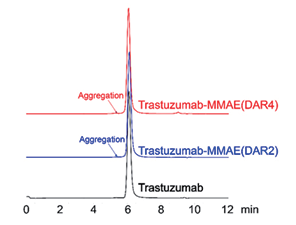
Figure 5. SEC-HPLC was performed to evaluate ADC aggregation. No observable peaks were seen in the resulting chromatogram, with less than 5% of antibody aggregation. Image Credit: ACROBiosystems
In vitro plasma stability test for AGLink ADCs
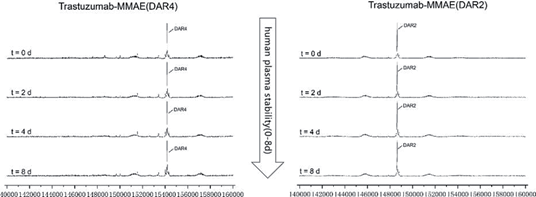
Figure 6. MMAE ADCs (DAR2/4) were spiked into human plasma and tested over 8 days and evaluated through LC-MS. Both types of ADCs were stable in vitro throughout the experiment. Image Credit: ACROBiosystems
In vitro cytotoxic activity assay

Figure 7. MMAE ADCs (DAR 2/4) were evaluated on its cytotoxicity to HER2 positive and negative cell lines. The ADCs developed in this study were proven to induce cell death in HER2 positive cell lines, while preserving cell viability in HER2 negative cells. Image Credit: ACROBiosystems
Conclusion
Site-specific modifications are seeing increasingly widespread use as the applications of ADCs continue to evolve. Glycoengineering, in particular, has been shown to be an especially beneficial approach for site-specific antibody conjugation methods.
The AGLink site-specific conjugation kit from ACROBiosystems leverages the benefits of glycoengineering. It performs an enzymatic modification method of IgG Fc glycans to perform conjugation.
AGLink requires no prior engineering of the amino acid sequence, resulting in stable antibody conjugates with minimal batch-to-batch variability. The AGLink technology employed in ACROBiosystems’ conjugation kit provides a unique site-specific conjugation method with an array of potential applications in preclinical of MMAE-ADC development.
References and further reading
- Fu, Z., et al. (2022). Antibody drug conjugate: the ‘biological missile’ for targeted cancer therapy. Signal Transduction and Targeted Therapy, (online) 7(1). https://doi.org/10.1038/s41392-022-00947-7.
- Theocharopoulos, C., et al. (2021). Antibody-Drug Conjugates: Functional Principles and Applications in Oncology and Beyond. Vaccines, 9(10), p.1111. https://doi.org/10.3390/vaccines9101111.
- Marei, H.E., Cenciarelli, C. and Hasan, A. (2022). Potential of antibody–drug conjugates (ADCs) for cancer therapy. Cancer Cell International, 22(1). https://doi.org/10.1186/s12935-022-02679-8.
- Yang, Y., et al. (2022). An Unexpected Single-step Glycosylation Enables the Construction of Antibody-Biomacromolecule Conjugates as Therapeutics. bioRxiv (Cold Spring Harbor Laboratory). https://doi.org/10.1101/2022.09.04.506510.
Acknowledgments
Produced from materials originally authored by An Ouyang, Spencer Chiang, and Chao Wang from ACROBiosystems.
About ACROBiosystems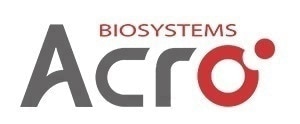
ACROBiosystems is a cornerstone enterprise of the pharmaceutical and biotechnology industries. Their mission is to help overcome challenges with innovative tools and solutions from discovery to the clinic. They supply life science tools designed to be used in discovery research and scalable to the clinical phase and beyond. By consistently adapting to new regulatory challenges and guidelines, ACROBiosystems delivers solutions, whether it comes through recombinant proteins, antibodies, assay kits, GMP-grade reagents, or custom services. ACROBiosystems empower scientists and engineers dedicated towards innovation to simplify and accelerate the development of new, better, and more affordable medicine.
Sponsored Content Policy: News-Medical.net publishes articles and related content that may be derived from sources where we have existing commercial relationships, provided such content adds value to the core editorial ethos of News-Medical.Net which is to educate and inform site visitors interested in medical research, science, medical devices and treatments.
Last Updated: Jun 30, 2025